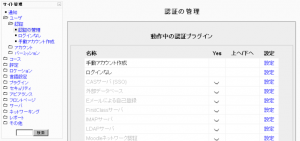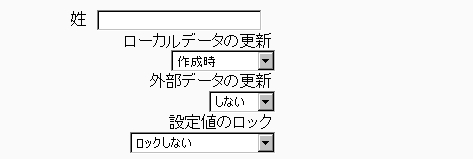認証の管理
作成中です - Mitsuhiro Yoshida 2009年8月27日 (木) 17:29 (UTC)
ロケーション: サイト管理 > ユーザ > 認証 > 認証の管理 (または、Moodle1.9以前のバージョンの場合、サイト管理 > ユーザ > 認証)
認証メソッドの設定
認証メソッドを閲覧するには:
- 「サイト管理 > ユーザ > 認証 > 認証の管理」にアクセスしてください。
- 「認証の管理」ページで、あなたが選択した認証プラグインを有効にするには、閉じた目のアイコンをクリックしてください。Moodle 1.8以降、あなたは、1つ以上の認証プラグインを選択することができます (下記、複数認証をご覧ください)。Use the up/down arrow icons to arrange the plugins in order, with the plugin handling the most logins at the top of the page.
- If you have chosen Email-based self-registration and wish potential users to be able to create their own accounts, select "Email-based self-registration" from the self registration drop-down menu in the common settings section. Potential users will then be presented with a "Create new account" button on the login page.
- If you have courses with guest access, set the Guest login button to show.
- Click the "Save changes" button.
- Click on Settings opposite the authentication plugin(s) you have chosen.
- Configure the required settings and click the "Save changes" button.
Multi-authentication
Moodle 1.8
From Moodle 1.8 onwards, multi-authentication is supported. Each authentication plugin may be used to find a username/password match. Once found, a user is logged in and alternative plugins are not used. Therefore the plugin which handles the most logins should be moved to the top of the page in order that less load is put on authentication servers.
共通設定
自己登録
If you wish users to be able to create their own user accounts, i.e. self-register, then select Email-based self-registration (or any other enabled plugin that can support self registration, like LDAP) from the drop-down menu. This will result in a "Is this your first time here?" instructions and a "Create new account" button being displayed on the login page.
Warning: Enabling self registration results in the possibility of spammers creating accounts in order to use forum posts, blog entries etc. for spam. This risk can be minimized by limiting self registration to particular email domains with the allowed email domains setting (see below). Alternatively, self registration may be enabled for a short period of time to allow users to create accounts, and then later disabled.
Note: The Email-based self-registration authentication plugin must be enabled to allow users who previously self-registered to login with that plugin. Selecting Email-based self-registration as the self registration method allows potential users to self register.
ゲストログインボタン
You can hide or show the guest login button on the login page. Hiding the guest login button disables guest access to the Moodle site, however logged-in users can still enter any courses which allow guest access without being required to enrol.
代替ログインURI
This should be used with care, since a mistake in the URL or on the actual login page can lock you out of your site. If you do mess it up, you can remove the entry from your database (table mdl_config) using, e.g., phpmyadmin for mysql.
パスワード喪失URI
Moodle 1.9
If your lost password handling is performed entirely outside of Moodle (for example, only by a help desk), you can set the url of that service here. Anybody pressing a "lost password" link in Moodle will be redirected to this URL. Note that this will disable all of Moodle's lost password recovery options regardless of authentication method(s) in use.
許可および拒否されるメールアドレスのドメイン
Authentication may be restricted to particular email domains when using Email-based self-registration so that, for example, only students with a university email can login.
(Note: Prior to Moodle 1.9, the allowed and denied email domains settings can be found in Administration > Server > Email.)
メールアドレスの変更時、ドメインを制限す
Moodle 1.9
In Moodle 1.9.3 onwards, you can choose to enforce email domains only when users create an account using Email-based self-registration i.e. after creating an account, users may change their email to a different domain.
ReCAPTCHA
A CAPTCHA is a program that can tell whether its user is a human or a computer. CAPTCHAs are used by many websites to prevent abuse from bots, or automated programs usually written to generate spam. No computer program can read distorted text as well as humans can, so bots cannot navigate sites protected by CAPTCHAs.
Moodle 1.9
From Moodle 1.9.1 onwards, spam protection may be added to the Email-based self-registration new account form with a CAPTCHA element - a challenge-response test used to determine whether the user is human.
ReCAPTCHA keys can be obtained from http://recaptcha.net by signing up for an account (free) then entering a domain. The public and private keys provided can then be copied and pasted into the recaptchapublickey and recaptchaprivatekey fields in the manage authentication common settings, and the changes saved.
In addition to setting reCAPTCHA keys, email-based self-registration should be set as the self registration authentication plugin in the manage authentication common settings and the reCAPTCHA element should be enabled in the Email-based self-registration settings.
Profile fields data mapping and locking
Most (but not all) authentication plugins that use an external source for the user account details allow us to retrieve some user profile details (like first name, last name, email, etc.). By using the Data Mapping section on those authentication plugins configuration page we can configure what, when and how to manage all those user profile details.
These fields are optional. You can choose to pre-fill some Moodle user fields with information from the external authentication source (if you are using one), from the fields that you specify here. If you leave these fields blank, then nothing will be transferred from the external authentication source and Moodle defaults will be used instead. In either case, the user will be able to edit all of these fields after they log in.
In addition to specifying how to fill this fields, we can set how to update them (in both directions, to Moodle or from Moodle), and whether we want to lock them (so the user cannot modify their value) or not:
- Update local: When the user field will be updated from the external authentication source:
- On creation: when the user account is created during the first login
- On every login: every time the user logs in (or there is a user synchronization, for those authentication plugins that support it). Fields set to update locally should be locked.
- Update external: When the external authentication source will be updated from the user field:
- Never: never update the external authentication source from Moodle.
- On update: the external authentication source will be updated when the user profile is updated. Fields should be unlocked to allow edits.
- Lock value: To prevent users from altering some fields (e.g. students changing profile information to inappropriate or misleading information), the site administrator can lock profile fields. It's usually a good idea to lock profile fields if you are maintaining this data in the external authentication system.
- Unlocked: The field is unlocked and can be edited by the user at any time.
- Unlocked if empty: The field is unlocked if it is empty, but once the user fills in some information, it becomes locked and cannot be edited any more.
- Locked: The field is locked and cannot be edited by the user.
If you are using a mixture of authentication types (such as IMAP and manual), then the fields you map and lock in the authentication options are specific to that particular authentication plugin. Each authentication plugin has its own set of mapped and locked fields.
Remember to test the field locking by logging in with the proper type of account! If you test with a manual account but have set the field locking to apply to IMAP accounts, you will not be able to tell if it worked!
関連情報
- 認証 - for list of authentication plugins
- Multi authentication in Upgrading to Moodle 1.8
- Using Moodle: User authentication forum
- Using Moodle Do users need e-mail addresses? forum discussion
- Using Moodle Admin approving self registrations? forum discussion


